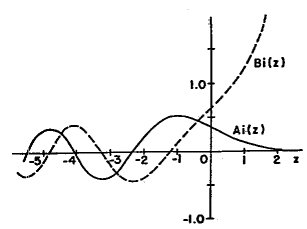

Problem:
Find the ground state energy of the He atom using the variational method.
Solution:
The adjustable parameter in our trial function is a = a0/Z'.
ψ(r1,r2)
is a product function, ψ(r1,r2)
= Φ1(r1)Φ2(r2).
Φ1(r1) = (1/πa3)½exp(-r1/a),
Φ2(r2) = (1/πa3)½exp(-r2/a).
<ψ|H|ψ> = <Φ1|H1|Φ1> + <Φ2|H2|Φ2>
+ <ψ|V12|ψ>.
We can also evaluate the integral directly. We write
![]()
To carry out the angular integration we then use
![]()
The integrals for the radial integration come straight out of common integral tables.
Problem:
Find the ground state energy of the He atom using the variational method.
Solution:
![]()
The eigenfunctions of H must be zero at x=0 and x=¥.
The
derivative dy/dx must be continuous at all x except
x=0. Any function that satisfies these boundary conditions can be written as a
linear combination of eigenfunctions of H and is an acceptable trial function
giving <H>>E0.
We may choose as the trial function for x>0 the eigenfunction of the first
excited state of the harmonic oscillator. It satisfies the boundary conditions. We choose
![]()
Note the change in the normalization constant, since we are only looking at x>0.
![]()
![]()
since <T> = <V>.
![]()
![]()
![]()
![]()
The exact solutions of
![]()
or
![]()
are the Airy functions y(z)=Ai(z), with boundary condition y(x=0)=0.

x=0 Þ z=-E/(Fx0). y(z) has its first zero at z=-2.338.
![]()
Calculate the splitting induced among the degenerate n=2 levels of a hydrogenic atom, when this atom is placed in a uniform electric field E pointing in the z-direction. This is the linear Stark effect. You may use the following explicit hydrogenic wave functions |nlm>:
![]()
![]()
![]()
![]()
and the fact that in general ![]() Hint: Exploit symmetries!
Hint: Exploit symmetries!
![]()
The energy of the proton in the field is ![]()
The energy of the electron in the field is ![]()
The potential energy of both particles is ![]()
Let us use first-order perturbation theory.
The first excited state is 4-fold degenerate.
![]()
To find E12 we have to diagonalize the operator ![]() in the subspace spanned by |200>,
|210>, |211>, and |21-1>. The matrix elements between states with the same parity
are zero. This implies that all diagonal matrix elements are zero and all elements between
states with the same l are zero. The matrix elements between states with different m
are zero. The only matrix elements left are <210|z|200> and <200|z|210>.
in the subspace spanned by |200>,
|210>, |211>, and |21-1>. The matrix elements between states with the same parity
are zero. This implies that all diagonal matrix elements are zero and all elements between
states with the same l are zero. The matrix elements between states with different m
are zero. The only matrix elements left are <210|z|200> and <200|z|210>.

![]()
![]()
We therefore have to diagonalize the matrix

in the |200>, |210>, |211>, |21-1> basis.

![]()
![]() (two fold degenerate ),
(two fold degenerate ),
or
![]()
The eigenvectors corresponding to E12=0 are |211> and |21-1>.
The eigenvector corresponding to E12=3qe|E|a|
is ![]()
The eigenvector corresponding to E12=-3qe|E|a|
is ![]()
The four fold degeneracy is changed into two non degenerate eigenvalues and one two fold degenerate eigenvalue.
